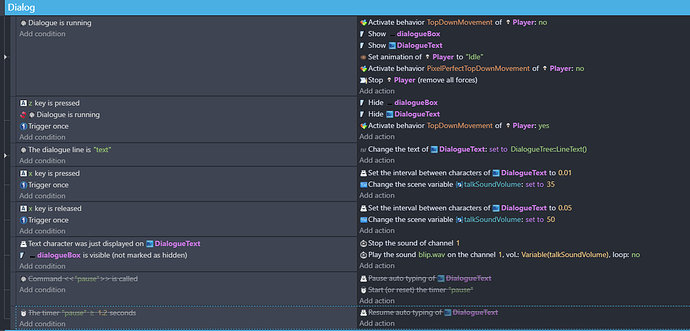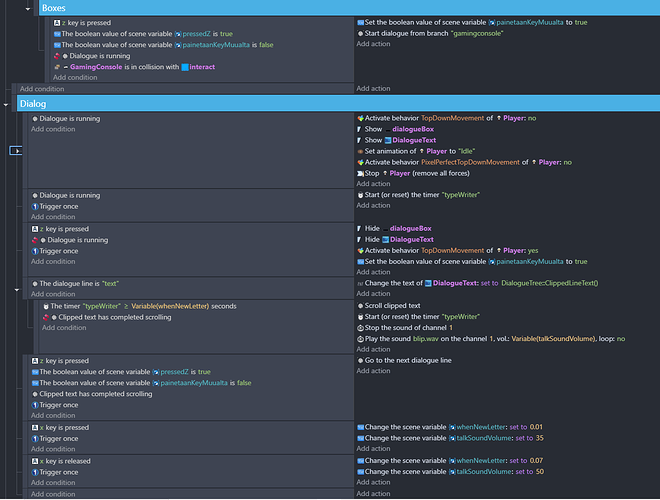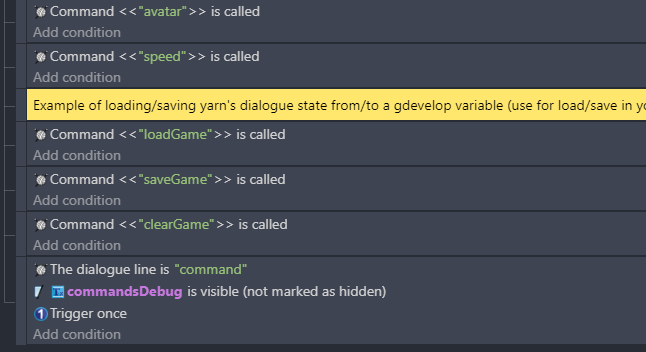Hi Valo, Sorry I can’t offer ongoing support, and this will have to be my last comment before I move on. You will find lots of posts about sound and other features by searching in the forum, and the Wiki is also a good place to learn GDevelop. GDevelop 5 documentation - GDevelop documentation
The official GDevelop YouTube channel also has lots of tutorials about general GDevelop use.
There’s nothing different about using sound with dialogue than using it for anything else in GDevelop. You could trigger a sound with a button press, when dialogue begins and ends, and even use a custom Yarn command to trigger sounds when certain parts of the dialogue are reached. I haven’t tried any of these things myself yet.
Yarn is tricky. It was one of the things I learned early on when I first began using GDevelop, which I think might be your case too. It was not the easiest place to start, but it did make sense with some practise, like most things. I’ve only been using GDevelop since last April, and I am far from being an expert. My main tip is to start easy. Get the basics up and running before trying to customise or change things.
Pausing (Wait): I don’t know why this doesn’t work for you. It works for me, using the classic set-up from my original tutorial. I tested Wait again this morning to make sure. Remember, in Yarn, that 1000 is one second, 2000 is two seconds, 500 is half a second etc. Sometimes seconds (1, 2.5 etc.) are used in GDevelop and sometimes milliseconds (1000, 2500 etc.) are used, so it can be a little confusing at times. I mention the Wait feature in my video, Yarn variables and conditional statements, 19:41, where I cover it briefly, but I don’t do anything different there to what I mentioned to you on this forum.
More about sound. I haven’t got much experience with using sound in GDevelop yet, but I use a coin collection sound effect in my Yarn variables and conditional statements video (07:40) which I made using the built-in sound effects generator.
‘Jitter’. I had a quick look at the ‘stop, remove forces thing’ and unfortunately this doesn’t seem to be an action that removes things like deacceleration from a platformer character. It’s to do with other types of forces in GDevelop that I haven’t used. There is no way currently to remove momentum from a platformer character and make them suddenly stop, and I expect the same applies to a top-down character. So I will continue to use my ‘fix’ to hide the little bit of movement that happens when dialogue and other things end (when platformer behaviour is enabled once more). This below event gets activated by my ‘dialogue is not running’ and ‘inventory gets closed’ and ‘quest log gets closed’ events:
Notes: (1) I target a group instead of a single platformer character because I have two versions of my character that I want to target. (2) My character has a blink, which I turn off during the fix to stop his eyes displaying weirdly. (3) Anywhere in my game that I want to use this fix, I use an action that sets jitterFix to true. The jitter fix event then runs and the variable gets set back to false near the end of it, ready to be used again. (4) It feels a bit hacky and I wouldn’t do a tutorial on it for that reason.
Best of luck with your game.
Edit: It seems you made an additional post about the jitter issue and made progress with it there, so I needn’t have spent time writing about this again today. Please remember to update comments where you ask for help if you have managed to solve the problem. As a side note: unfortunately, setting the current speed of the character before disabling platform behaviour doesn’t remove all of the jitter for me, hence my work-around, but I’m glad it’s worked for you with your top-down game.






